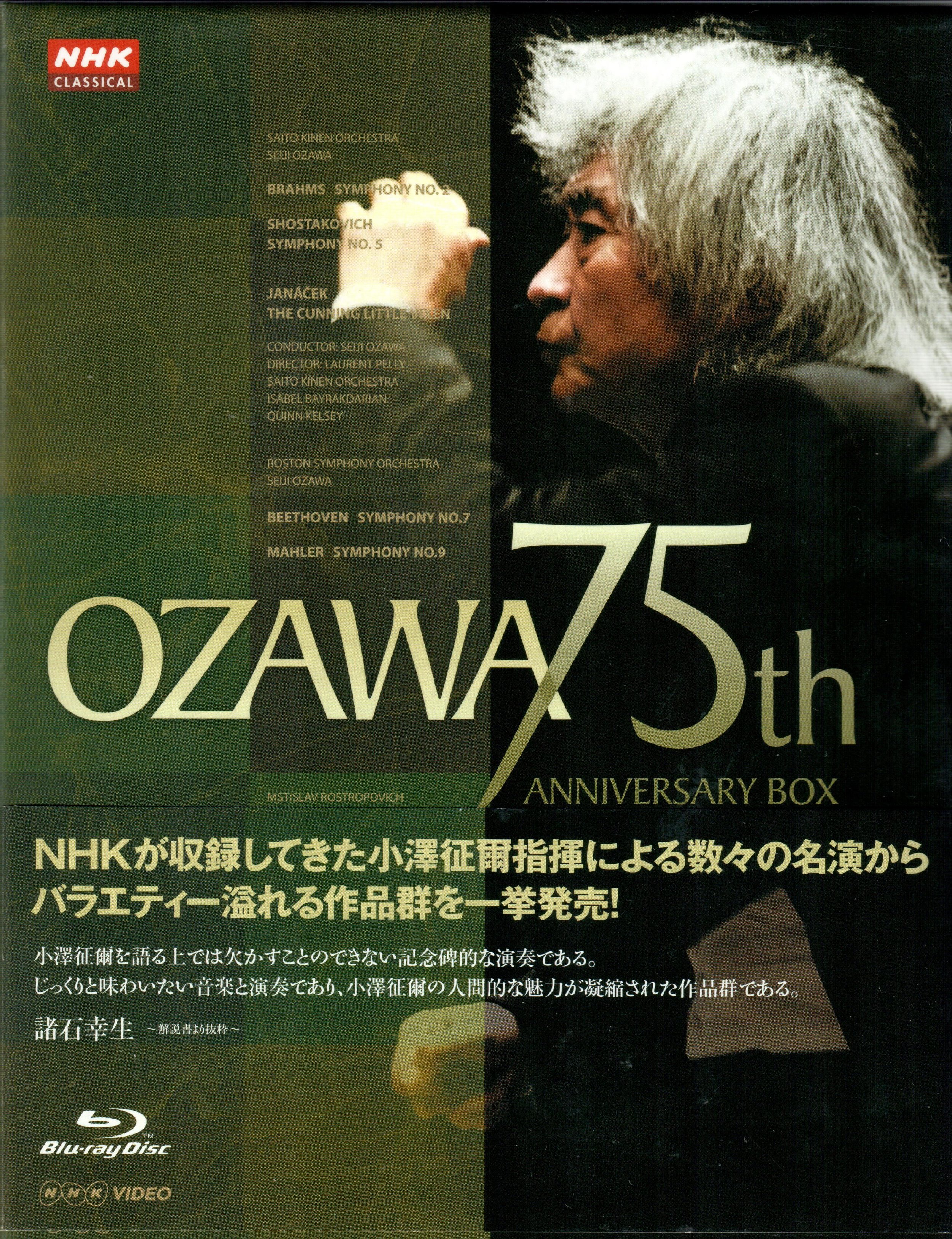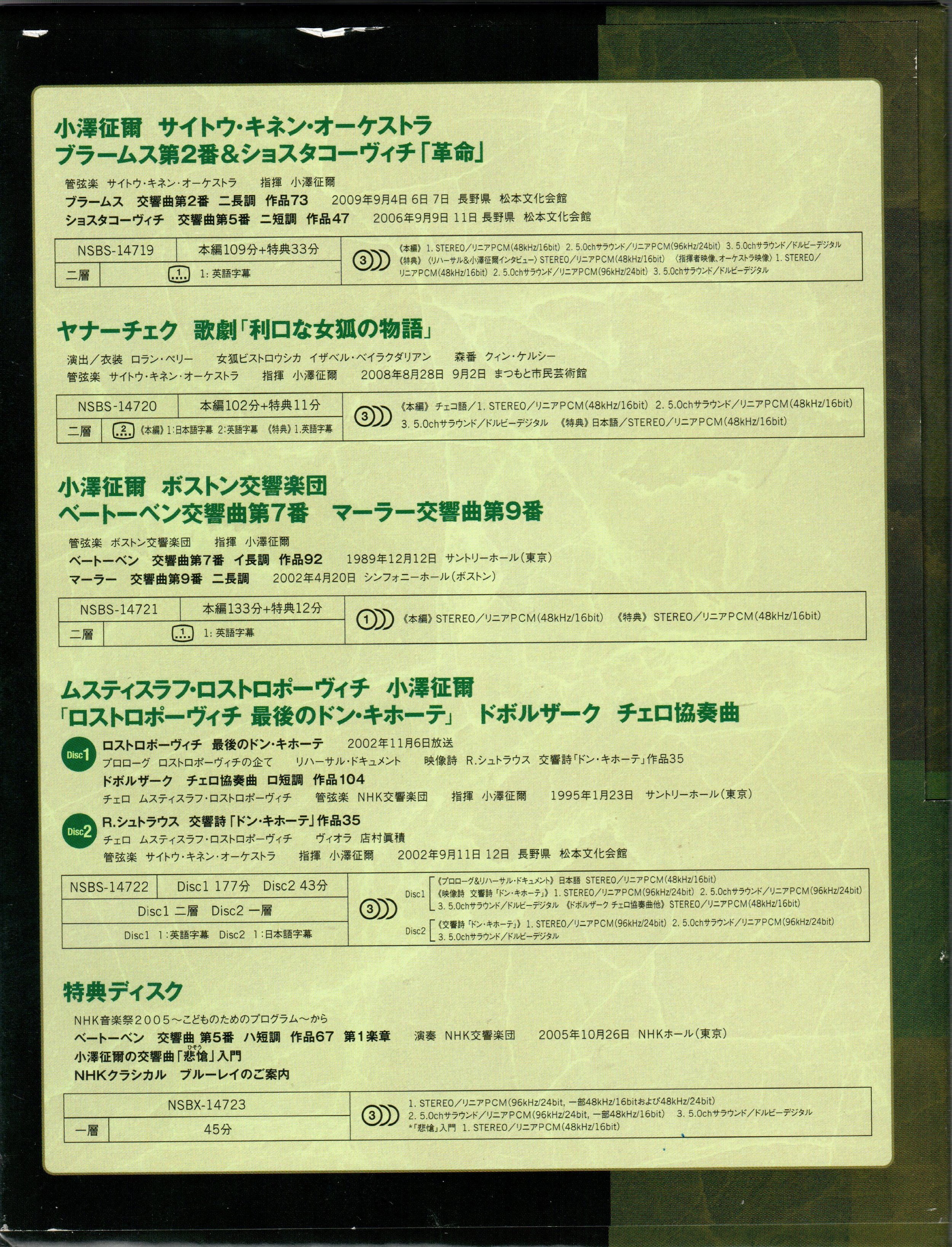

Seiji Ozawa 75th Anniversary Box Set. This set has 5 Blu-ray jewel boxes:
Brahms Symphony No. 2 & Shostakovich Symphony No. 5. This is a superb HDVD that you can buy separately. We graded both titles A+ elsewhere on this site.
Janáček Cunning Little Vixen. This is a nice HDVD that you can buy separately. We graded it B+ elsewhere on this site.
The Last Don Quixote. Mstislav Rostropovich and Seiji Ozawa playing Strauss's Don Quixote. This is a complicated two disc set. Disc 2 is the main show—a performance (43 minutes) of Don Quixote from 2002 with the Saito Kinen Orchestra. This performance has decent video and was recorded with 5.0 PCM 96 kHz/24 bit surround sound. Disc 1 is a strange mixed bag. It has a 1 hour, 15 minute documentary, with good video and 5.0 PCM 96 kHz/24 bit surround sound, about the Don Quixote recording. The documentary includes rehearsal video with a lot of personal information about Rostropovich. The documentary also has a fanciful Don Quixote movie (43 minutes) that illustrates the Cervantes story as told by Strauss in the tone poem. Then follows a 1995 concert with Rostropovich and the NHK Orchestra playing the Dvořák Concerto for Cello. This performance has remarkable good video but there is only stereo sound (which is quite good).
Beethoven Symphony No. 7/Mahler Symphony No. 9. This disc has material shot in 1989 & 2002 and does not meet our standards for an HDVD.
Extras Disc. This disc doesn't have an NSBS catalog number like the other disc packages because its just extras, including two short tutorials about western music from Ozawa & trailers for NHK HDVDs. This is all in Japanese with no subtitles. Some material is in SD & stereo. The value of this part of the set is nil for Japanese speakers and 0 for westerners.
So we can sum up the boxed set as follows: it has two fine titles (1 & 2 above) you can buy separately and an odd title (3 above) with a lot of material about the Strauss Don Quixote plus a recording of the Dvořák Concerto for Cello. Then there are two jewel boxes (4 & 5 above) you can throw away.
Next here is a mini-review by Wonk William Huang about The Last Don Quixote title (which has two discs as explained above):
“The Last Don Quixote two-disc Blu-ray set commemorates the friendship of Seiji Ozawa and Mstislav Rostropovich. On Disc 1 is a live 1995 performance of the Dvořák Cello Concerto. Also on Disc 1 is a generous documentary with extensive rehearsal shots as Rostropovich prepares for a 2002 performance of Richard Strauss' Don Quixote tone poem. Finally, Disc 1 has a "music video" for you to watch as you listen to the 2002 Don Quixote performance. Disc 2 has only one presentation: a live recording of the 2002 Strauss performance of Don Quixote.
Let's look closer at Disc 1:
Dvořák's Cello Concerto. In this live Suntory Hall performance, the sixty-seven year old Rostropovich still plays Dvořák's Cello Concerto with vigor, intelligence, and drama. The recording is very worth while even if it is not of full HDVD quality. There are a few rough edges in the first movement from both the soloist and orchestra. Rostropovich occasionally does not hit the center as precisely as he used to, and his level of assurance is a bit less compared to the EMI DVD with Giulini. But it is a live performance, and there are no glaring technical errors that break the spirit of the music. Rostropovich is fully warmed up by the time he plays the first movement coda, and the concert really takes off after that. While the NHK orchestra leaves some room to desire, the proactive players make a good effort to accompany the legendary soloist.
Sarabande. As an encore to Dvořák's Cello Concerto, Rostropovich plays the Bach Sarabande in D minor in memory of 5,000 victims of the Kobe earthquake. He turns in an inspired, touching performance. After watching this concert, I [William Huang] viewed the same Sarabande on his 1991 Bach EMI DVD. What a contrast! The analogue video quality was abysmal, like a cheap camcorder recording a dark room. More importantly, the NHK performance was more sublime than Rostropovich's earlier and more famous EMI video.
Our subject 1995 film features more logical camera work than the EMI DVD release directed by Hugo Kach. When we see Rostropovich in our film, it's usually a good shot. Although the cameraman sometimes lingers on the woodwinds and Rostropovich's back too long, it's not disastrous like the mannered mess that Kach filmed years ago with its chaotic montage of headshots and irrelevant, claustrophobic shots of everyone else. The crisp picture of this 1995 Blu-ray resurrects a healthy, energetic Rostropovich. Surprisingly, the 1995 video is in higher definition than the later 2002 Strauss performance. Seiji's magnificent mop of hair is clearer in this earlier performance, and we can see sweat-beads drop off the musicians.
Documentary. Also on the first disc is a 2002 documentary with interviews and rehearsal footage of Rostropovich preparing Don Quixote. There is invaluable material here as Rostropovich eloquently describes, with demonstrations on both piano and cello, the development of Strauss's mastepiece.
Strauss Music Video. The music video is not very successful. It uses dated computer animations and generally inept re-enactments to illustrate Cervantes' masterpiece. The obscure Georgian director does not deliver a visual interpretation worthy of Cervantes or Strauss. A more recommended exercise would be to view Gustave Dore's Don Quixote illustrations while listening to Rostropovich's superior 1975 EMI recording.
Now let's consider Disc 2 of The Last Don Quixote. This 2002 Japanese performance of Don Quixote has more balanced camera work than Rostropovich's 1975 collaboration with Herbert von Karajan on Deutsche Grammophon. But the cellist is past his prime in 2002 (whereas his powers were merely on the decline in the 1995 Dvořák discussed earlier). It is remarkable that at age 75 Rostropovich can play through this whole difficult work by heart, but his playing is labored and dry. Don Quixote is fiendishly complex work. It's more a symphony than a showcase piece for a soloist, and it requires all players to be in top form. It's a very cerebral piece that also requires a varied emotional palette. While the Saito Kinen Orchestra is well rehearsed in this performance, they don't reach the brilliant, moody heights achieved by the Berlin Philharmonic playing Don Quixote under von Karajan.”
What should make of this 5 disc hot mess? There were rumors that the Rostropovich disc would be issued separately. But now it appears you will have to buy the boxed set to get it. So should you do this? Even though Slava was maybe past his prime in 1995 when the Concerto for Cello was recorded, the expert opinion of William Huang is that this recording is well worth having. Rostropovich was 7 years older in 2002 when the Don Quixote project was recorded. But this was part of the master's retirement celebration, and he was fired up. The Don Quixote material has good PQ and SQ. We don't want to forget that Rostropovich was more than a great musician. He was a great Russian patriot and dissident (when that was still dangerous) and suffered exile from his homeland. The more we watched, the more impressed we were by his humanity, his generosity, how much fun he was having working on the concert disc and the (basically goofy) movie version of Don Quixote. I was a newbie to Don Quixote. It's a delightful piece, and I'm glad I learned quite a bit about it from Slava! True, the NHK disc authorship of the Rostropovich package is chaotic. But we are glad we have it, and we give it the grade of B+. If you have a special interest in Rostropovich as a man, then you would probably treasure this Rostropovich package.
You can buy this box from www.amazon.co.jp. Good luck!